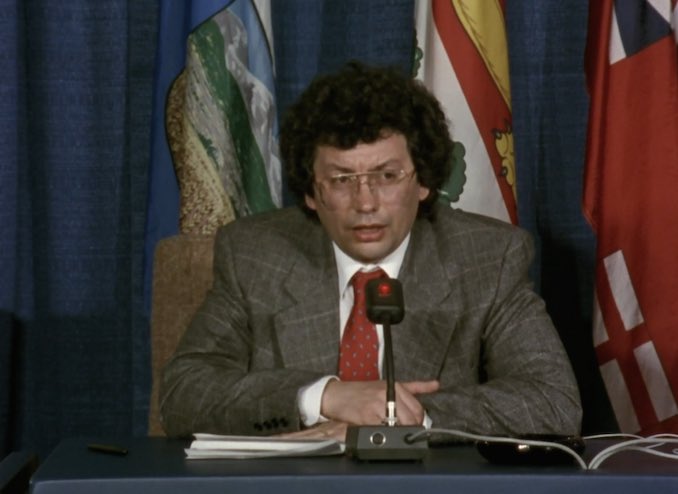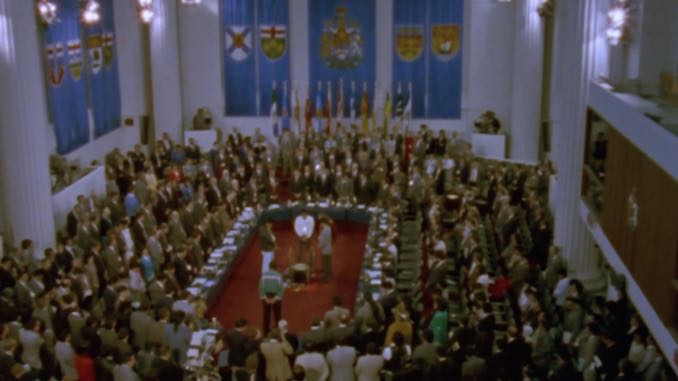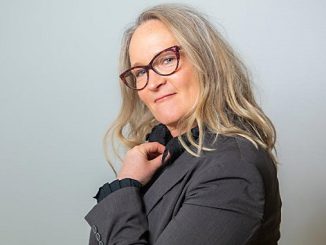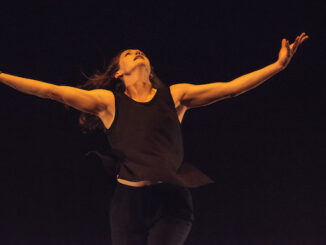Dancing Around the Table Part One and Dancing Around the Table Part Two, are both NFB documentaries directed by Maurice Bulbulian.
In 1980, triggered by the repatriation of the Canadian Constitution, Representatives of Native Peoples in Canada travelled to London to petition the Queen over their exclusion from this constitutional process. They succeeded at two things: enshrining Indigenous rights in the Constitution under Section 35, and the creation of a series of Federal/Provincial Conferences of First Ministers on Aboriginal Constitutional Matters.
It is these conferences that are depicted in the two documentaries.
The films are composed of clips taken from the floor of the actual conferences, along with clips of Indigenous leaders made before, during and after the conferences. Pt I covers the first 3 conferences held in 1983, 1984, and 1985, while Pt II covers the final one in 1987.

Pt I opens with 70-year-old Kwakiutl elder, Ethel Pearson speaking from her homeland in Kingscome Inlet, BC. Returning after a long absence, she explains the intimate relationships between Indigenous peoples, land, and identity, but laments that “none of that matters in the eyes of the White Man”, who only values his pocketbook.
“Now that I am talking from where I was born” she muses, “I wish I was younger so that I could start a revolution.” This sentiment is repeated throughout the film, and other promises made in it come to pass.
Voice over from Ethel’s son Bill Wilson, a key negotiator in these conferences, clarifies immediately the perspective of these documentaries: these conferences held great promise, but were reduced to nothing but mere ‘dancing around the table.’
“The difference in attitude that exists at the constitutional table…” an exasperated Wilson sighs “On the one hand we have the Aboriginal Representatives talking about Rights in the Constitution, on the other hand, we have the Prime Minister and the Premiers, talking like used car salesmen, with their desire to ‘make a deal’ … with no guarantee, and no substance.”
The Prime Minister during the first two conferences is the always-polarizing Pierre Trudeau, whose legacy seems destined to sour over time like vinegar, instead of developing into fine wine. The blatant racism and disrespect displayed by Trudeau in these films is both shocking, and to be expected. Coming before major journalistic efforts that exposed institutionalized racism while reporting on issues such as Starlight Tours, Missing and Murdered Indigenous Women, or Residential School Grave Recoveries, the tenor with which Trudeau addresses the Indigenous leaders reflects the arrogance of a country that still believes it can get away with murder. In a flagrant display of colonial disrespect, Trudeau interrupts the opening prayers being made by the Indigenous representatives to pray the “Our Father” over top of them. In English first, then French, and even Latin.
Later in Pt I, Bill Wilson states that he has two children who want to become lawyers and prime minister, both Indigenous women. After an outburst of laughter from the largely white, male audience Trudeau replies, “Tell them I’ll stick around until they’re ready.” Over 30 years later, his daughter Jody Wilson-Raybould, became Canada’s first Indigenous Minister of Justice and Attorney General in the government of Justin Trudeau. Promises made, promises kept.

Brian Mulroney replaces Trudeau as PM for the last two conferences. In contrast to the condescending, bad boy charisma of Elder Trudeau, Mulroney offers an equally powerful charismatic presence. Yet his charm is almost more dangerous – a soothing honey voice offering empathetic assurance of a desire to reach a deal, all while offering still nothing.
Several Premiers in this film cement their legacies as arrogant colonial oppressors who worked at every turn to sabotage Indigenous Peoples, their contemptuous gazes and mocking laughter forever immortalized on film. But so too are the words of Jim Sinclair, a prominent Métis leader immortalized, as he delivers powerful condemnations against Premiers such as Grant Devine of Saskatchewan and Bill Vander Zalm of British Columbia. When Vander Zalm and Devine hide behind their constituents as an excuse to block any proposed deal, Sinclair holds up letters of support from churches, unions and town councils and shoots back “I think it’s unfair for you to accuse all of Saskatchewan of racism, when you’re the one advancing it at this table today.”

Only the Premier of New Brunswick, Richard Hatfield, seems willing to speak the truth. “When we started on this course, I can’t believe there was anyone that didn’t know that the Aboriginal Peoples were going to ask for self-government. They’ve been very specific about what they meant, and they’ve been willing to compromise. They’ve acted admirably. I’m not very proud of the way the first ministers have responded.”
The conferences ultimately end with no deal and are judged to be “unsuccessful” for this reason. Yet the conferences succeeded in creating a strong sense of solidarity and resilience between Indigenous peoples. “I think the clearest expression of how everybody felt is when [we] stood up” says Chief George Watts. “If we were a defeated people, we would have never stood up. And I didn’t see the White People stand up, because I don’t think they felt very good.”
Produced in 1987, these docs remain ever relevant. Indigenous issues are often poorly taught in schools, poorly represented in the media, and Canadians generally make no effort to independently study our past. Yet it’s full of recognizable characters and offers us a deeper, necessary context to a question that will not disappear no matter how hard Canadians wish it would: the question of Indigenous Land Title and Inherent Rights. These docs disrupt the myth of a quest for ‘handouts’, and instead, portray a people stating their rights to create an economic base on their own lands and using their own resources, to develop and support sustainable economic practices.

These documentaries also challenge the notion of Indigenous peoples as a defeated people. “What we are talking about at the table is a relationship,” says Joe Mathias, the hereditary chief of the Squamish First Nation. “Not as a subjugated people, but we are talking as a Nation of Peoples, creating a relationship with White Society.”
We are offered a glimpse into a different kind of society that could be created here in Canada. Speaking to his fellow Indigenous leaders after the failed conferences, Chief George Erasmus from the Dene Nation laments:
“When you sit down with those Premiers, and you sit down with their Prime Minister (and it doesn’t really matter what Prime Minister you sit down with) you actually see that they don’t have much of an idea of what the world should really look like. They really don’t have much of an idea of how people should relate with their environment. And they certainly don’t know how human beings should respect each other. They have no real concept. They can’t build the kind of society that Native People can build. What we’re holding out, is solutions to how human beings, human societies can have dignity. How we can take care of the poor. How we can employ people. How we can live in balance with the universe”.

His sentiments are shared by Inuit leader John Amagoalik who proclaims “This conference fails, because these people have no vision.”
The rhetorical skills and vision of the Indigenous Leaders on display in this film are truly remarkable, and many of their vows made in the film to continue the fight have been vindicated with the passage of time. At the end of the conference, and a particularly rousing speech, Métis leader Jim Sinclair promises “We have the right to self determination, to self government and to land. And the people that are here are going to go back and continue the struggle. This is not an end, it’s only the beginning. We broke new roads for those who will come in the future. Don’t worry Mr. Prime Minister, Premiers of the Province, I may be gone, but our people will be back.”
The Métis especially made good on this promise. After being locked out of Treaties and ignored by the Federal Government for decades, in 2016 The Supreme Court of Canada ruled 9-0 that Métis and non-status Indians are Indians under the Constitution, and the federal government’s fiduciary responsibility to Indigenous Peoples is well established under existing law. Since that ruling, the Métis Nations of Alberta, Saskatchewan, and Ontario have all secured self governing agreements.

Yet Canadians are still are largely in the dark about these agreements and the legal rights that Indigenous Peoples do have. These documentaries can help Canadians to comprehend the legacy of distrust built up towards the Government of Canada, and the degree to which Indigenous Peoples have been continuously disrespected for decades. This is a legacy which must be understood and acknowledged in order for any reconciliation to take place.
Dancing Around the Table Part One and Dancing Around the Table Part Two, are both available for viewing free at nfb.com




